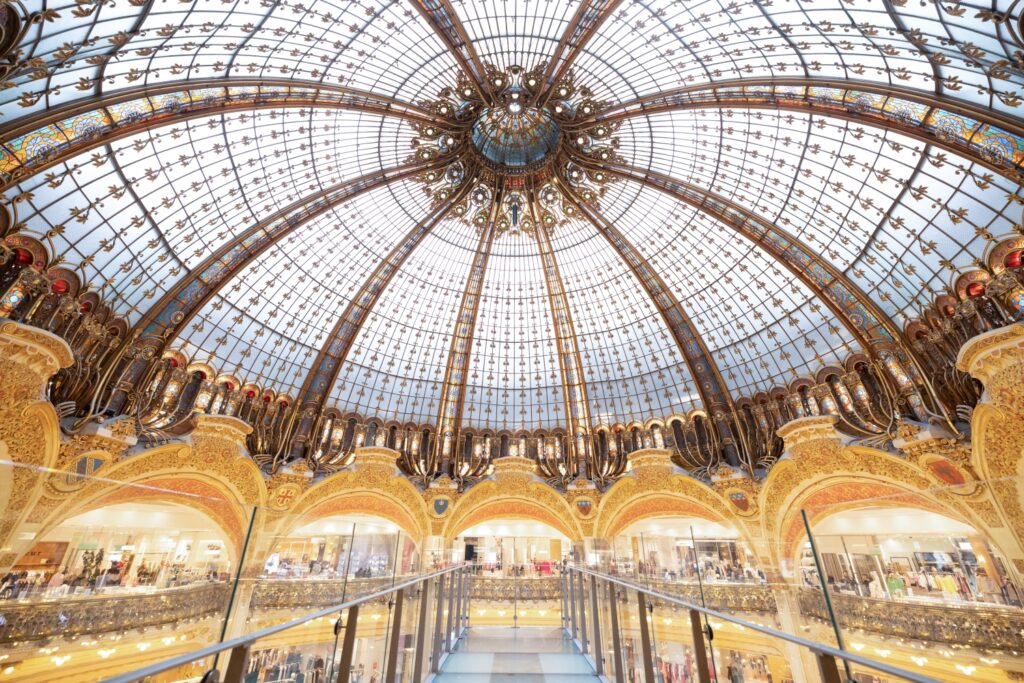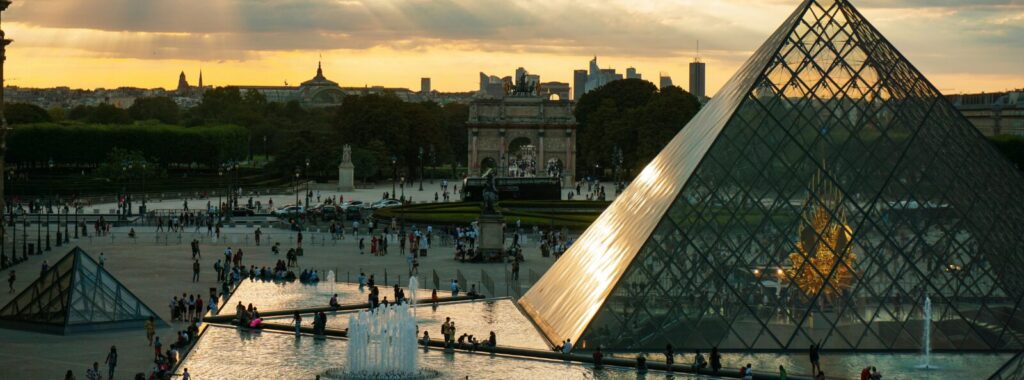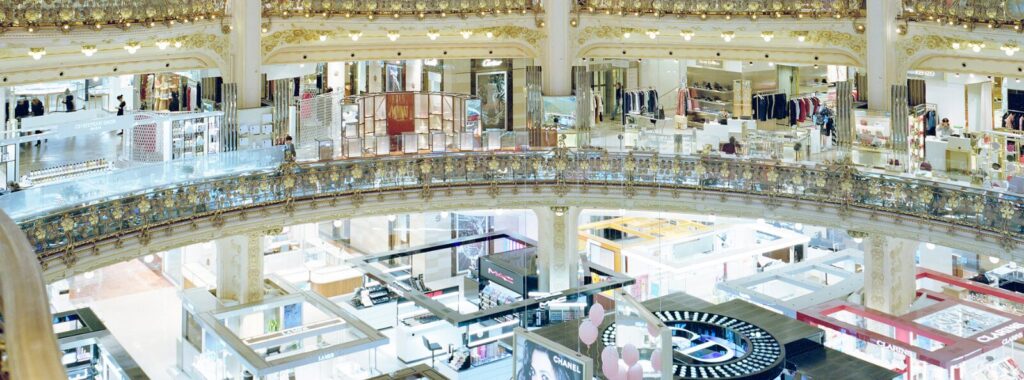The story of Paris has evolved over centuries. The buildings of the city display remarkably diverse architectural styles that transport visitors through France’s historical milestones, art, and lifestyles. Whether you are looking to admire the timeless landmarks or discover bold masterpieces of modern architecture, you’ll find everything you want in the city. From a grand hotel, to a metro entrance, to a doorway… Paris is alive with examples of stunning architectural elegance.
Explore the iconic architecture of Paris
Paris is filled with legendary landmarks that reveal the spirit and history of the city. Here are some must-see places to add to your itinerary.
The Eiffel Tower: the most famous building in Paris

The Eiffel Tower is perhaps the most iconic and most famous building in Paris. But you may be shocked to know that it was only intended to be temporary and should have been removed after twenty years. And believe it or not, when Gustave Eiffel’s Eiffel Tower was first erected in 1889 as part of the World Fair, many people thought it was unimaginably ugly. Parisians hated the building and gasped in horror at the sight of it.
However, as history showed, it’s in the French DNA to hate and love in equal proportion. Maupassant couldn’t bear the tower but, interestingly, always had breakfast at the tower’s restaurant. He argued that it was the only place in town where he couldn’t actually see the Eiffel Tower! Gustave Eiffel loved his tower so much that he built himself a cozy little apartment on the third floor, where he would hold private meetings with the science elite. Exorbitant sums of money were later offered to Eiffel for his flat, but he never agreed to sell it.
Good to know 📝
At Galeries Lafayette Paris Haussmann, you can enjoy gourmet food, delectable French pastries, and experience one of the best views of the Eiffel Tower at the same time.
The Notre Dame de Paris: a church that symbolizes the Parisian spirit

Notre Dame is much more than just a church. This magnificent building lies right in the heart of Paris, as indicated by the Point Zero metal plate embedded on the cathedral’s square. Located on Île de la Cité, Notre Dame de Paris has been overlooking the banks of the Seine for more than 850 years. While the famous Gothic cathedral is worshipped today, it wasn’t always loved and taken care of. During the French Revolution, it was even turned into a food and wine warehouse!
Yet, despite centuries of neglect, wars, and revolutions, Notre Dame still stands proud. In 1802, Napoleon restored the cathedral and was crowned Emperor of the French Republic within its walls two years later. Additional restoration work took place thanks to the rise in the cathedral’s popularity following the release of Victor Hugo’s novel Notre-Dame de Paris. The tragic 2019 fire is just another episode from which the cathedral is sure to bounce back, emerging even more impressive and beautiful than before.
The Louvre: a mix of history and modernity

Nowhere is the harmony between the ancient and the contemporary more evident than at the Louvre. Its striking glass pyramid reflects the beautiful building, originally built as a fortress in 1190. 800 years later, newly elected French president, Francois Mitterrand, commissioned architect IM Pei to revamp the museum. Pei came up with the idea of creating a new entrance in the middle of the courtyard, topped by a steel and glass pyramid built in the same proportions as the famous Pyramid of Giza. The concept behind the structure was to bring light to the underground extension. Unsurprisingly, the project drew harsh criticisms and was initially seen as an architectural joke.
Today, the Louvre, along with its pyramid, is the most visited museum in the world. Approximately ten million visitors a year travel from across the globe to see this remarkable building and the artworks within it.
Beaubourg: home of the renowned Centre Pompidou gallery

Centre Georges Pompidou is an iconic symbol of 20th-century modern architecture. The quirky building houses the largest museum of modern art in Europe and is also an artistic and music research center.
The exterior of the building displays an “inside out” design featuring all of its internal facilities. Its façade displays brightly colored tubes, pipework, glass elevators, and mechanical systems. The top floor of the Centre Georges Pompidou also offers some of the best views over Paris.
Good to know 📝
The Centre Georges Pompidou is currently undergoing extensive renovations and will be closed from late 2025 to 2030.
Palais Garnier: the most famous opera house in the world

Another fabulous Parisian building not to be missed is the Palais Garnier. Sometimes referred to as the Opéra Garnier, this architectural wonder was first inaugurated in 1875. Architect Charles Garnier designed the Palais in the style of Napoleon III. It is a remarkably opulent building that is nothing less than breathtaking in its magnificence. It’s not without reason that it is known as “the most famous opera house in the world”.
Combining elements of Baroque, Palladio, and Renaissance architecture, the Palais Garnier was the home of the Paris Opera until 1989. Visitors can still enjoy exquisite ballet and masterful operatic performances today. Guided tours are also available, offering the chance to experience this iconic building in all its majesty.
Grand Palais: the glory of French art
The 1900 World’s Fair saw the birth of the beautiful Grand Palais upon the Avenue des Champs Elysées in Paris. The palace was constructed using stone, steel, and glass. The process of building the incredible glass roof of the royal palace was an immense undertaking. More than 8,500 tons of steel were required. This is even more metal than was used to build the Eiffel Tower!
To this day, the Grand Palais’ glass roof is the largest of its kind in Europe. With its wrought-iron structure, mosaic floor, and limestone steps, the grand staircase of the palace is a masterpiece of Art Nouveau style. The Grand Palais was to become home to fine art exhibitions and events. It continuously hosted events, only pausing during WWI when the monument was requisitioned to serve a period as a military hospital.
Discover the peculiar, picturesque architecture and history of Paris
Paris is not just about wide boulevards and grand cathedrals. The city hides countless unexpected curiosities.
Nicolas Flamel’s house
Built in 1407 and believed to be the oldest stone house in Paris, this is where Flamel is said to have carried out his experiments in alchemy. It is also where many believe he discovered the mysteries of the Philosopher’s Stone. While there is no evidence to confirm that Flamel actually participated in any such activities, the house provides a fascinating insight into medieval Paris.
A dispute over the smallest house
Many believe that the tiny house located at 13 Quai Voltaire and overlooking the river Seine is the narrowest building in Paris. However, the smallest house in Paris is to be found in the 10th arrondissement on the Rue du Château d’Eau. This micro building measures 1.10 meters wide and five meters high. It is tucked away between two buildings on a bustling street, opposite the Town Hall of the district.
This little space was originally a passageway between two streets. This sparked many disagreements concerning who owned the rights of access to the passageway. In order to end the endless disputes, it was decided to fill the gap with a new property. The addition left the neighbors with nothing to argue about.
The red Pagoda: a Chinese palace in Paris
The Pagoda is a striking anomaly amid the uniformity of Paris’s Haussmann-era architecture. In 1925, collector and dealer Ching Tsai Loo purchased what used to be a standard house in the French Louis Philippe style. To showcase his incredible collection of Asian antiques, Tsai Loo undertook a massive transformation of the building and turned the house into a Chinese Pagoda from the inside out. Its striking red façade and sloping roof clash with the surrounding 19th-century architecture, making the Pagoda an unmissable architectural oddity.
Step Inside the Story of Galeries Lafayette
To truly immerse yourself in the architectural history of Paris, consider joining a guided heritage tour of Galeries Lafayette Haussmann. You’ll learn the hidden stories behind its stunning design and gain a deeper understanding of Paris’ history and architecture. For something even more innovative, you can take part in Galeries Lafayette’s immersive augmented reality project. A truly unique experience, this tour transports you through time and lets you see the landmark in a whole new way.


Paris Art Nouveau: Unmissable Architectural Gems
From the metro to shopping places, Art Nouveau can be found everywhere in the capital.
Paris and its relationship with Art Nouveau
The Art Nouveau movement of architecture and design flourished in Paris from approximately 1895 to 1914, reaching its high point at the 1900 Paris World Fair. With its organic features inspired by nature, Art Nouveau aimed at modernizing and breaking free from the linear, restrictive forms of classical art, architecture, and design.
The architects of Art Nouveau invigorated the Haussmannian monotony of Paris with an infusion of movement and color. It was here that this burgeoning style found a home at the Maison de l’Art Nouveau. The movement even took its name from the building!
Paris is home to many examples of Art Nouveau architecture. Visitors can see Art Nouveau everywhere in Paris. Parisian museums, hotels, metro entrances, and doorways throughout the city showcase the Art Nouveau aesthetic.
The remarkable architecture of Galeries Lafayette
At the heart of Galeries Lafayette lies an architectural masterwork: “la coupole”, which is listed as a Historical Monument.
Good to know 📝
To truly immerse yourself in the architectural history of Paris, take a guided heritage tour of Galeries Lafayette Haussmann. You can also take things a step further with Galeries Lafayette’s immersive augmented reality project that transports you through time!
On the 8th of October 1912, the Great Hall of Galeries Lafayette was inaugurated. 43 meters above ground level, a beautiful steel-framed glass Art Nouveau cupola sits on top of the hall. A stunning sweeping staircase leads to the cupola. The cupola is supported by ten concrete pillars linked by arches. These loggias have wrought iron balconies overlooking the hall. The center of the cupola is topped by a small dome adorned with colored stained-glass panes. The balconies and ceiling are decorated with carved and painted floral patterns, a distinctive signature of Art Nouveau.
Along with the remarkable three-branched theatrical staircase, the creation of this masterpiece was achieved by leading Art Nouveau artists from the School of Nancy. Constructed in bronze, forged iron, printed iron plate, paint, and gold, the fantastic French Art Nouveau stairs originally took shoppers from the ground floor to the first floor. Unfortunately, the staircase was considered to take up too much valuable retail space. It was dismantled in 1974 and replaced with escalators. However, you can still see a section of it next to the elevators.
When visiting Galeries Lafayette don’t forget to look up !





